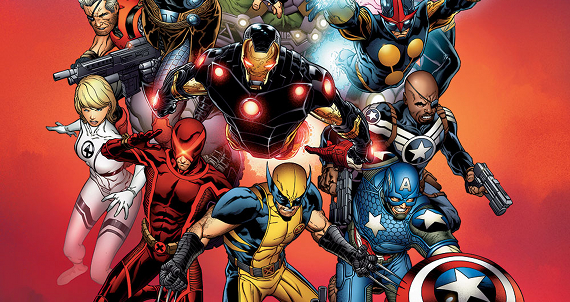The relaunch. The reboot. The retcon.
The functions of these strategies are to effectively wrap current story lines and to allow them to start anew in an effort to expand fan base as well as cater to loyalists who have grown weary of the sequence of events.
The terms are commonplace in the comic book industry. Last week, entertainment giant Marvel released "Uncanny Avengers," the first book of its NOW! initiative. Through February, long-running titles such as Amazing Spider-Man and Uncanny X-Men will end in favor of brand new and re-titled first issues. Last August, DC Comics showed its stones when it canceled its entire line of superhero books to pave the way for its New 52—52 separate titles that reset everything in the DC Universe.
In the sport of boxing, every bout has a story line. From negotiations and training through the actual battle itself, each has a unique current and crescendo capable of captivating audiences. HBO’s 24/7 and Showtime’s All Access are examples of shows that offer fans insiders’ views on chapters previously not witnessed by outsiders. So, in essence, the aforementioned terms can be applied to the sweet science since new negotiations begin shortly after each bout.
Boxing should take a page out of the comic industry’s book and actively promote a “jumping on point.” What better time than now, a bit more than a week removed from the tremendous junior welterweight scrap between Brandon Rios and Mike Alvarado?
With nary a clinch, Rios and Alvarado waged war on each other for nearly 20 minutes before referee Pat Russell called a halt to the brutality when he felt Alvarado was no longer responding healthily to the onslaught of Rios. It was special from the opening bell, its intensity ushering in a new standard of how much matchmaking matters.
A fight of such high caliber immediately elicits rematch cries. Surely HBO, who broadcasted the bout on its Boxing After Dark series on Saturday, will aim to acquire such a sequel should it happen. In the meantime, the network would be well-served to make the match available to as many viewers as possible and equally as often.
It has the possibility to set a new precedent: “This is boxing now. This is the new standard.” That’s what comic creators would do.
It wouldn’t be the first time the two mediums intersected. In fact, boxing and comics seemingly follow similar paths. Both waver in popularity among the general public while maintaining a rabid fan base. They are wont with epic slugfests and riveting sagas. Then there’s the hero factor: Many athletes assume monikers based on comic characters, and — fairly or not — many are idolized by spectators.
Adonis Stevenson scored an impressive 12th-round stoppage of the tough Don George for the chance to face IBF titlist Carl Froch the Friday before last. Nonito Donaire, No. 6 on TQBR’s pound-for-pound list, continued his takeover of the junior featherweight division with a technical knockout of Toshiaki Nishioka in the main event of the Rios-Alvarado classic. Paul Williams, who Showtime featured in a pre-taped interview with Jim Gray before the Saul Alvarez-Josesito Lopez bout, proved a body can be broken but hope is indestructible.
Superman. The (Filipino) Flash. The Punisher.
The fighters are brimming with personality, launching themselves into peril for fans’ collective pleasure. The casual fan who clamors for a more competitive heavyweight division may be missing the dominance of Andre Ward, the magnificence of Sergio Martinez, the relentlessness of Rios, the vigor of Alvarado. These are just a few of the sport’s top fighters and, for the overwhelming majority, they don’t seem to be ducking and weaving their ways out of quality matchups.
Like a crisp and creaseless first issue of a comic book, each bout sets forth with its own distinctive tone. A potential viewer of the Dec. 8 bout between Manny Pacquiao and Juan Manuel Marquez doesn’t necessarily need to watch the pair’s trilogy to enjoy the fourth fight. Likewise, if interested, the three previous ragers will be recapped on 24/7.
This is now. Boxing has a jump start on a stacked late-2012 slate, which includes:
Marco Huck vs. Firat Aslan
Vanes Martirosyan vs. Erislandy Lara
Abner Mares vs. Anselmo Moreno
Antonio DeMarco vs. Adrien Broner
Carl Froch vs. Yusaf Mack
Roberto Guerrero vs. Andre Berto
Austin Trout vs. Miguel Cotto
Rafael Marquez vs. Christian Mijares
TV coverage is certainly not an issue — Showtime aired a four-fight card on Saturday — so it’s up to promoters to generate crossover appeal.
Rios-Alvarado, with the hyphen infinitely connecting the two like writer-artist teams on Marvel NOW! teasers, draws comparison to a certain fight from five and a half years ago that converted casual fans to avid fight freaks. Gears should be in motion to make it such, too.
See, once a product stales, it’s time to repackage. That’s what the two major comic book publishers did. Boxing doesn’t need an overhaul. The product is quality. What it needs is packaging, and it has received a lot of help from social media as Showtime and ESPN have been aggressive about fan interactivity. The information society we live in offers so many opportunities for outreach. Every individual who loves the sport should use these platforms to the advantage of publicizing the current state of the game.
In comics, mighty characters fall and rise from the ashes like the Phoenix. But boxing doesn’t need redemption despite unfounded claims of its demise. The sport simply owes it to itself to establish what it is today and how it will proceed into tomorrow.

